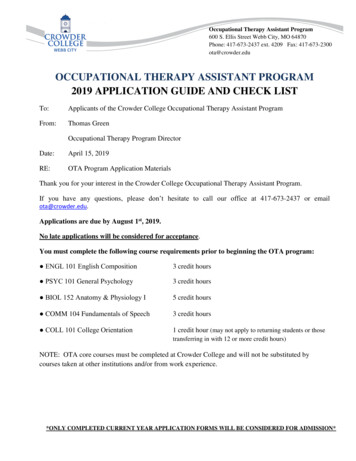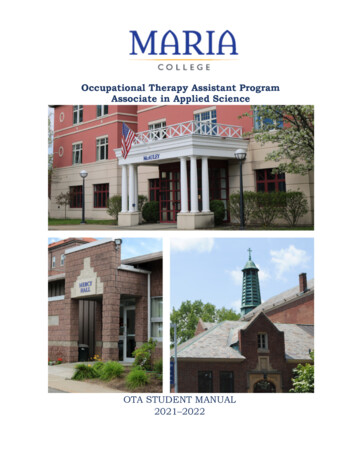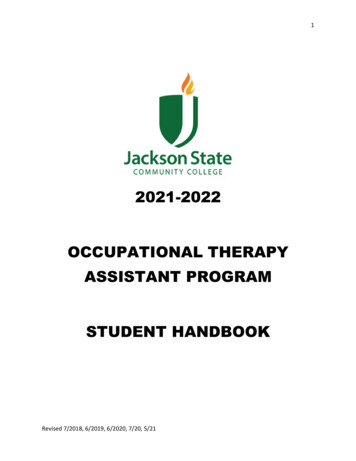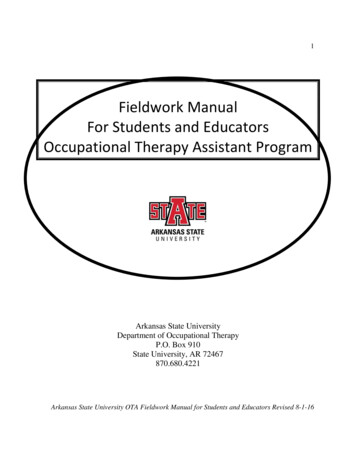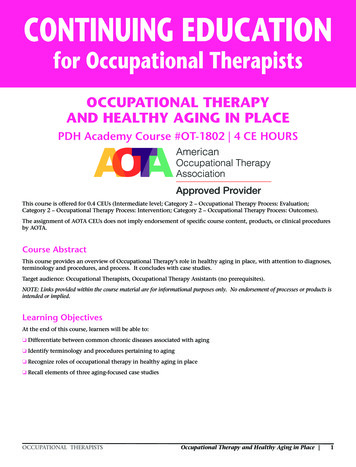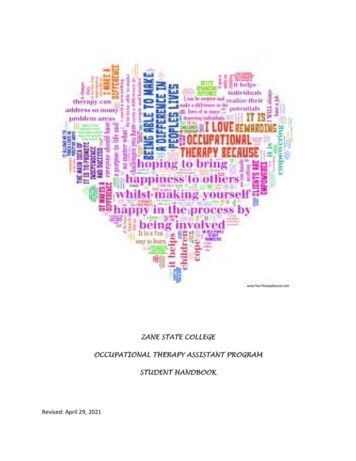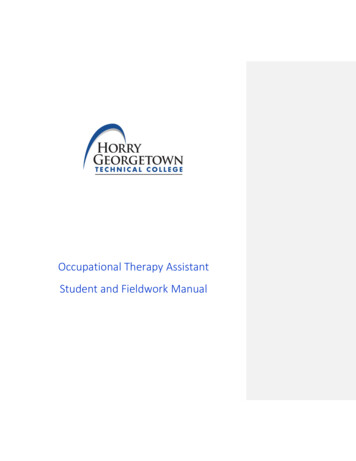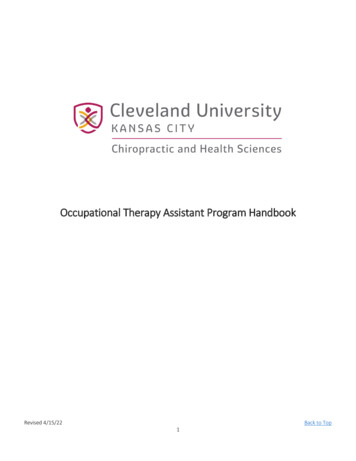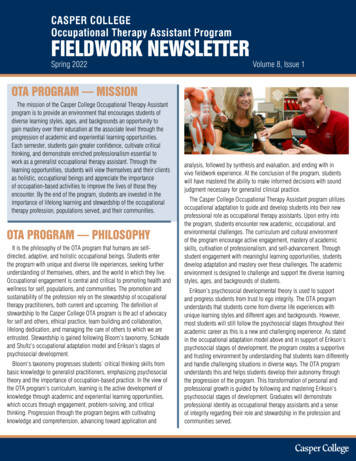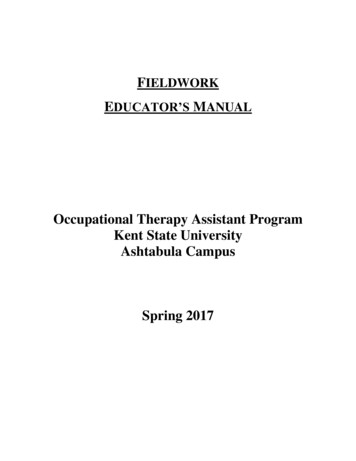
Transcription
FIELDWORKEDUCATOR’S MANUALOccupational Therapy Assistant ProgramKent State UniversityAshtabula CampusSpring 2017
TABLE OF CONTENTSCURRICULAR DEISGN . 1Program Curriculum Design . 2Program Mission 2Program Philosophy 3Program Goals and Student Objectives . 4Course Requirements 8Fieldwork Experience . 9Evaluation of Fieldwork Performance . 12CONTRACT AGREEMENT PROCESS 14Contract Agreement Process 15Fieldwork Educator’s Qualifications 16Fieldwork Responsibilities . . 17Fieldwork Experience Student Supervision . 19PLACEMENT PROCESS .23Student Placement Process and Schedule . 24Fieldwork Schedule . 25Fieldwork Rotation Reservation Form (Example) 26STUDENT FIELDWORK REQUIREMENTS .27Student Fieldwork Requirements . 28Student Responsibilities . 29FIELDWORK POLICIES AND PROCEDURES .32Fieldwork Policy and Procedures . 33Progression Standards and Readmission . 34Behavior Policy 37Attendance/Hours/Weather . 38Student Counseling / Remediation . 39Change in Medical Condition 39Parking and Dress Code Policy 39Social Network Policy . 40Smoke and Tobacco-Free Environments . 40Safety at Off-campus Sites . 41PROBLEM STUDENT/REMEDIATION .42Remediation . 43Sample Remediation Plan . 44
LEVEL I FIELDWORK .46Level I Fieldwork Assignments . 47Level I Fieldwork Performance Evaluation Directions . .48Level I Fieldwork Psychosocial Performance Evaluation Form .49Level I Fieldwork Physical Disabilities Performance Evaluation Form . 54Level I Fieldwork Objectives . 55Self-Assessment . 56Level I Student Evaluation of Fieldwork Experience . 59LEVEL II FIELDWORK 61Level II Fieldwork Assignments . 62Level II Fieldwork Objectives . 63CODE OF ETHICS . .64Code of Ethics 2015 . 65
KENT STATE UNIVERSITYASHTABULA CAMPUSOCCUPATIONAL THERAPY ASSISTANT PROGRAMThe Occupation Therapy Assistant Technology Program is fully accredited by theAccreditation Council for Occupational Therapy Education (ACOTE) of the AmericanOccupational Therapy Association (AOTA), 4720 Montgomery Lane, Suite 200,Bethesda, MD 20814-3449, (301) 652-AOTA.Graduates of accredited programs will be able to sit for the national certificationexamination for Occupational Therapy Assistants administered by the National Board forCertification of Occupational Therapists (NBCOT). After successful completion of theexam, the individual will be a Certified Occupational Therapy Assistant (COTA). Moststates require licensure in order to practice; however, state licensures are usually based onthe results of the NBCOT Certification Examination.
CURRICULAR DESIGN1
Curriculum Design(Standards A.6.3 – A.6.5)Institution MissionWe transform lives and communities through the power of discovery, learning and creativeexpression in an inclusive environment.Occupational Therapy Assistant Technology MissionThe Occupational Therapy Assistant Technology Program at Kent State University shares theeight campus network mission to advance quality student education and clinical competency tofulfill key societal goals for a diverse cultural region. Through the pursuit of excellence inpersonal and professional development, students will demonstrate the ability to utilize criticalthinking, and clinical reasoning to complete therapeutic interventions based on knowledgeacquired from theory, technical skills and research. This knowledge and newly acquired skillswill lead to an Applied Science Associate Degree in Occupational Therapy AssistantTechnology, and eligibility to become certified and licensed to practice, under the supervision ofa Registered Occupational Therapist.2
Program PhilosophyOur department has the following beliefs about occupational therapy. Humans are intrinsicallymotivated to master their environment through the successful performance in daily activities or“occupations” (purposeful and meaningful engagement in life activities). Mastery of occupationsis usually achieved in the course of normal development with adaptive skills being learnedsequentially. The program believes that occupational development occurs through sequentialacquisition of skills. The student initially develops competency in psychosocial skills andtheories which are utilized throughout the curriculum and are therefore presented early in theprogram. The next step in occupational development is acquiring skills in physical dysfunction.Competency in pediatric populations requires the combination of the previously acquiredknowledge with specialty skills and therefore this is presented later in the program. The KSUOCAT Program prepares students to address occupational needs of culturally diverse populationsin facilities and the community.Mental or physical illness or disability at any stage may interrupt the ability to successfullyparticipate in occupations, tasks or activities and adapt to the environment. Occupational therapyencourages and facilitates occupations and occupational roles through the restoration orenhancement of function, adaptation of the environment and/or teaching compensatorytechniques. The individual’s acceptable capacity to interact with the environment within thelimitation of a disability will result in improved quality of life through the collaboration of theOT practitioner, client and others. Occupational therapy also promotes health and wellness, theability to participate in occupations and the occupational role for diverse populations at all stagesof life (AOTA, Definition of Occupational Therapy for the AOTA Model Practice Act).The program at Kent State University believes that learning is a dynamic developmental processinvolving one’s cognitive, affective and psychomotor skills. Bloom’s Taxonomy or “learningdomains” illustrates this process defining how students expand their knowledge and developintellectual skills, grow emotionally and acquire technical skills related to occupational therapyservice delivery. Students are admitted into the program with varied values, beliefs and attitudes,differing degrees of interaction skills and limited understanding of the profession. It is theprogram’s responsibility to foster creative problem solving, critical thinking, and clinicalreasoning skills to facilitate development in the unique knowledge, skills and attitudes pertainingto the profession.REVISED 8/20163
Program Goals and Student Learning OutcomesIn keeping with the Program Philosophy, the curriculum design is based on thedevelopmental model and utilizes Bloom’s Taxonomy when determining program goals andstudent learning outcomes. Themes/threads were designed to guide student learningoutcomes within the three learning domains. Each domain increases in complexity.Themes/Threads of the curriculum:1. Professionalism2. Clinical reasoning3. Occupation-based, client-centered OT Practice4. Community-based practiceLevels of the curriculum:1. Affective – growth of feelings and emotional areas (attitude)2. Cognitive – mental skills (knowledge)3. Psychomotor – manual or physical skills (skills)Professionalism:Professionalism provides the foundation for ethical and professional behaviors, the intra- andinterpersonal skills required to be an effective member of an inter-professional team, lifelong learning, and the ability to advocate and promote the profession.Affective1. Recognizes professional behaviors that are the foundation of the profession.2. Accepts responsibility for developing values, beliefs and attitudes that are congruent withthose of the profession.3. Develops self-confidence, intra- and interpersonal skills to successfully contribute to aninter-professional team environment.4. Develops intrinsic motivation to embrace life-long learning and continued professionalcompetency.Cognitive1. Understand the need for self-assessment as a method of determining areas requiringpositive change for ongoing personal and professional growth and development.2. Understand AOTA’s Code of Ethics, Core Values and Attitudes, and Standards ofPractice as the basis for professional behavior.3. Integrate insight, intuition, empathy and inquisitiveness when providing OT services andinteracting with diverse populations.4. Analyze professional needs to seek strategies to enhance knowledge base, increaseeducation and training and explore various aspects of the profession to become a lifelong learner.5. Synthesize and integrate professional behaviors to become an advocate for clients and theprofession.4
Psychomotor1. Utilize professional behaviors when interacting with clients, peers and other professionalswhen providing OT services.2. Become a life-long learner.3. Advocate for clients and the profession.4. Participate in professional organizations.Clinical ReasoningThe program describes clinical reasoning as the cognitive process of making the best clinicaldecisions throughout the therapeutic process. Clinical reasoning is a skill that is developedthrough education, practice and experience. It is highly influenced by client factors andcontext, theory and frames of reference, evidence based practice, and skill of theoccupational therapy assistant.Affective1. Adopt an attitude toward life-long learning and client-centered OT practice in preparationfor a skilled level of clinical reasoning in OT practice2. Develop intrinsic motivation to explore professional literature to increase knowledge inthe profession.3. Adopt the critical curiosity to observe and reflect on one’s own thinking, emotions, andtechniques; developing the willingness to acknowledge and correct errors.Cognitive1. Identify and synthesize the processes involved in clinical reasoning.2. Develop knowledge of theories and frames of reference and their impact on clinicalreasoning3. Understand and analyze professional literature as it relates to the decision making processin practice.4. Synthesize professional literature to develop evidence-based practice skills with clientinterventions under the supervision of an occupational therapist.Psychomotor1. Integrate evidence based practice findings throughout delivery of the OT process.2. Utilize clinical reasoning, when determining appropriate interventions to support clientparticipation in occupations and the occupational role.3. Integrate clinical experiences with evidence-based practice and personal reflections topractice to prioritize evaluation information, select appropriate treatment modalitiesand adjust practice based on client-specific situations and settings.5
Occupation Based, Client-Centered OT Practice:This is defined as identifying the meaningful occupations of the person and including them as“active participants in the therapy process”; understanding how their physical and/orpsychosocial conditions may impact performance; and infusing context, environment, andrelevant life aspects into improving the person’s roles and goals.Occupational therapy practice provides services ranging from evaluation to provision ofinterventions to outcomes based on the client’s presenting symptoms, conditions, and/ordisability.Affective:1. Examine basic occupations, client factors, context and environment, and the occupationalprocess in order to understand the correlations in OT practice with clients.2. Realize the meaning of occupation in relation to physical and/or psychosocial sequelae.3. Develop a preference for occupation-based and client centered clinical decision making.Cognitive:1. Understand the use of meaningful occupations to support a client’s participation andenhance roles towards health and wellness.2. Provide OT services to diverse populations based on each client’s specific contexts.3. Integrate theories and frames of reference into interventions to improve client skills inrelationship with occupation and the environment.4. Synthesize knowledge to support client “achieving health, well-being, and participationin life through engagement in occupation,” according to the tenets of the OTPF:Domain and Process.Psychomotor:1. Utilize occupation during academic lab activities and fieldwork placements to promotethe client’s growth and success in achieving personal objectives.2. Apply techniques to grade and/or adapt the client’s activities to provide the ‘just-right’challenge to encourage achievement of goals.3. Support the client’s desired occupational roles and participation in occupations through acreative, holistic approach.4. Collaborate with inter-professional team members to provide best practice, valuedservices to each client based on individual needs.Community-Based PracticePractice in this area “includes a broad range of health-related services: prevention and healthpromotion, acute and chronic medical care, habilitation and rehabilitation, and direct andindirect service provision, all of which are provided in community settings. Communitymodels are responsive to individual and family health needs in homes, workplaces, andcommunity agencies. The goal in community-based practice is for the client and thepractitioner to become integral parts of the community.”Affective1. Describe competencies and characteristics required of OT practitioners to be effective inmeeting the occupational needs of community.6
2. Explain the paradigm shifts or differences in the medical and community models,therapeutic and professional relationships between healthcare providers and communitymembers, terminology, decision making processes, and cultural impact on service delivery.3. Recognize individuals, groups, and populations in the community who have limitedability to participate in healthy occupations and accept our professional responsibility asadvocates of positive occupational opportunities.4. Recognize populations that may have limited access to occupations due to variouscircumstances.Cognitive1. Define and understand the terms health promotion and disability prevention and therelationship to community health and the quality of life.2. Summarize occupational risk factors and the role of OT in developing problem solvingsolutions to improve engagement in occupations to meet the needs of the community.3. Determine populations that are at risk for limited occupations and promote opportunitiesto meet their needs.4. Analyze the effects of engagement in occupations with individuals, groups andpopulations on their quality of life.Psychomotor1. Advocate for community members by promoting opportunities for participating inoccupations and linking them to overall health promotion and disability prevention activities.2. Seek out individuals, groups and populations within the community and identifyresources and opportunities to assist in improving their occupations.References:American Occupational Therapy Association. (2014). Occupational Therapy PracticeFramework: Domain & Process (3rd edition). American Journal of Occupational Therapy,68,S1-S48.Scaffa, Marjorie E., S. Maggie Reitz. (2014). Occupational Therapy in Community-BasedPractice Settings, 2nd edition. Philadelphia: F.A. Davis.7
Kent State University at AshtabulaOCCUPATIONAL THERAPY ASSISTANT PROGRAMSuggested sequence of courses for completing the program in two yearsCourse Number******Course TitleCredit HoursFIRST YEARSpring SemesterBSCI11010Anatomy and Physiology for Allied Health IKENT CORE COMPOSITION ELECTIVEPSYC11762General PsychologyUS10097Destination Kent State: First Year ExperienceSOC12050Introduction to SociologyKENT CORE HUMANITIES OR FINE ARTS ELECTIVE* BSCI* OCATOCAT110201000010003* NURS* PSYC* 10092Summer Semester (following acceptance into program)Anatomy and Physiology for Allied Health IIFoundations in Occupational TherapyOccupational Therapy Practice Skills LabFall SemesterHuman Growth and DevelopmentPsychology of Adjustment ORAbnormal PsychologyAnalysis of MovementOccupational Therapy Practice Skills IITherapeutic Techniques I--PsychosocialFieldwork 1a333133163216333434118SECOND YEARSpring Semester* KENT CORE MATH ELECTIVEOCAT20000Therapeutic Techniques II--Physical DysfunctionOCAT20092Fieldwork 1bOCAT20001Professional Issues in Occupational TherapyOCAT20003Occupational Therapy Practice Skills IIIPTST20001Therapeutic Communications in PT/OTOCATOCAT2000420006OCAT20192OCAT20292OCAT ELECTIVESummer SessionsTherapeutic Techniques III--Developmental DisabilitiesTherapeutic Techniques IVFall SemesterClinical Applications IClinical Applications IITOTAL REQUIREMENTS:34123114336441969 Hours* Indicates the open enrollment courses. These courses can be taken prior to admission to the OCAT Program.NOTE: The curriculum listed above does not include prerequisite. It is highly recommended that some openenrollment courses be taken prior to admission to allow a more manageable credit load during program and aDecember graduation following the second year of the program.8
Fieldwork ExperiencePurposeThe purpose of the fieldwork experience is to provide occupational therapy students with theopportunity to integrate academic knowledge with application skills at progressively higherlevels of performance and responsibility. The unique contributions of fieldwork experienceinclude the opportunity to test first-hand the theories and facts learned in academic study and torefine skills through client interaction under the supervision of qualified personnel. Fieldworkalso provides the student with situations in which to practice interpersonal skills withpatients/clients and staff and to develop characteristics essential to productive workingrelationships.Supervised fieldwork experiences in occupational therapy are an integral part of both theeducational process and professional preparation. It is intended to complement academicpreparation by offering additional opportunities for growth, for learning to apply knowledge, fordeveloping and testing clinical skills and for validating and consolidating those functions thatcomprise professional competence. The goal of the educational process is to produce competentoccupational therapy practitioners. Upon completion of Level II fieldwork education the studentis expected to function at or above the minimum entry-level competence. Therefore, fieldworkexperiences should be developed to offer opportunities for development of the necessary skillsand abilities identified in the role delineation report.Levels of FieldworkLevel ILevel I fieldwork includes experiences which are designed to provide students with anopportunity to observe and participate in selected field settings. These experiences are notexpected to emphasize independent performance. They offer exposure in psychosocial, physicaldysfunction, and/or pediatric settings in order to provide a student with some background tobegin a Level II experience. The student MUST pass the Level I fieldwork experience toprogress in the program. No part of Level I fieldwork may be substituted for Level II fieldwork.The Level I fieldwork experiences, OCAT 10092 Fieldwork 1a and OCAT 20092 Fieldwork 1b,are associated with OCAT 10002 Therapeutic Techniques I-Psychosocial and OCAT 20000Therapeutic Techniques II-Physical Dysfunction courses. Each of these courses encompasses 80hours of fieldwork attendance (two, 40 hour experiences).Level II (C.1.13)Level II fieldwork is intended to emphasize the application of an academically acquired body ofknowledge by providing the student with an in-depth “hands on” experience in delivery ofoccupational therapy service to patients/clientsLevel II fieldwork experiences (OCAT 20192 - Clinical Applications I and OCAT 20292 –Clinical Applications II) are required to be a minimum of 16 weeks. Each Level II experience9
lasts eight (8) consecutive weeks, completing full-time hours, complying with the work scheduleof the assigned facility. Level II fieldwork rotations are scheduled after the coursework has beensuccessfully completed. Upon completion, a pass/fail grade will be given for each Level IIrotation. The student may complete Level II fieldwork in a minimum of one setting if it isreflective of more than one practice area, or in a maximum of three different settings. Level IIfieldwork may be completed on a part-time basis as long as it is at least 50% of the full-timeequivalent.Note: Fieldwork experiences must be successfully completed within 18 months of the didacticcoursework.Fieldwork Manual/SeminarsAll students are required to purchase the Fieldwork Manual at the beginning of the secondsemester of their first year. This book contains formats for various fieldwork assignments, Codeof Ethics, Standards of Practice, note writing styles, and reimbursement information. FieldworkSeminars are mandatory and will be conducted throughout each semester in order to prepare thestudent for each fieldwork experience. The student will be required to submit writtenassignments to the Academic Fieldwork Coordinator in addition to the theory courseassignments.Student Assignment of Fieldwork SitesFieldwork site placements are decided on by the Academic Fieldwork Coordinator and/orProgram Director of the Occupational Therapy Assistant Technology Program. Students willhave the opportunity to submit their choice of settings, but the final decision is the responsibilityof the Academic Fieldwork Coordinator.When assigning a student to a placement, the student’s place of residence and preference will betaken into consideration, but it may not always be possible to accommodate all requests. Thestudent will likely be required to complete fieldwork assignments out of the local county area.Most fieldwork sites are within a 60 mile radius of the student’s residence. Occasionally studentsrequest out of state placements for the experience. These requests should be discussed with theAcademic Fieldwork Coordinator at least 6 months in advance to allow time to establish acontract with a new facility. The distance to some Level II fieldwork sites may make temporaryrelocation advisable. Students wishing to secure temporary housing closer to a facility will beresponsible for their own room and board in most cases.Students may not be placed in a facility due to the following circumstances: 1.) facility where arelative is employed in the same department or unit, 2.) facility where a Level I fieldworkexperience was completed in the same setting, and 3.) facility where student has worked or isworking. 4.) facility where an immediate family member is a resident, an enrolled student, or isreceiving services.Students are responsible for their own transportation and related expenses (meals, parking, etc.).The student who expects to complete the Program must be able to meet this financial obligation.10
Students may NOT contact facilities as a potential fieldwork site. If they have a facility in mind,they are to notify the Academic Fieldwork Coordinator. This is to ensure that properdevelopment of the placement site occurs and to prevent miscommunication.If the student is unable to complete the entire fieldwork component of his/her education, thestudent will be unable to meet the academic requirement of the OCAT Program. Any studentunable to meet all of the academic requirements of the Program will be dismissed.To ensure both patient and student safety and because of contractual agreements with communityagencies, students must follow certain professional practices. Prior to the assignment of the firstLevel I fieldwork experience, all students must demonstrate proof of liability insurance, medicalexamination, CPR certification, current immunizations and criminal background check. Formsare provided to the student at new student orientation. The one or two step Mantoux and criminalbackground check must be repeated annually with results submitted to the Academic FieldworkCoordinator. Any changes in health status, due to injury, medical condition, etc. should bereported to the Program Director as soon as possible.11
Evaluation of Fieldwork Performance (C.1.10)Level I Fieldwork ExperienceAll fieldwork is graded on a pass/fail system. The student must pass the Level I fieldworkexperience to continue to progress in the program. A passing grade is based on the followingcriteria:1.Students are to complete all assignments as noted in the student syllabus for eachcourse and turned in to the Academic Fieldwork Coordinator on or before theassigned due dates. Three or more late assignments results in a failure of thefieldwork rotation.2.The Fieldwork Educator evaluates the student’s performance utilizing the Level IFieldwork Performance Evaluation form supplied by the KSU OCAT Program.Students must pass by receiving no more than one “U” or unmet expectations (asindicated on the form).Level II Fieldwork ExperienceThe student will receive a pass/fail grade at the end of both Level II fieldwork experiences(OCAT 20192 and OCAT 20292) by the Academic Fieldwork Coordinator using the followingcriteria:1.Student completes each assignment as noted in the course syllabus. Assignments withdesignated due dates must be turned into the Academic Fieldwork Coordinator duringthe fieldwork rotation to ensure timely correction and submission of a final gradebefore graduation. Three or more late assignments result in failure of the fieldworkrotation.2.Each student will be evaluated by the Fieldwork Educator using AOTA’s FieldworkPerformance Evaluation. The student must pass this evaluation with a 70% or higherto pass the Level II fieldwork experience. A student may repeat a fieldworkexperience one time. If the repeated experience is not passed the student will bedismissed from the Program.3.A student who has failed a previous OCAT or related course and fails a Level IIfieldwork experience will be dismissed from the program. Both failures indicate afailure to progress in the OCAT Program.The Fieldwork Educator provides written documentation, evaluation, and feedback regardingstudent performance to the Academic Fieldwork Coordinator, by completing the AOTAFieldwork Performance Evaluation at mid-term and final. It should include both the rating scalescores and written comments for each performance criteria, as well as summative comments andsignatures. The rating scale is scored based on expectations of an entry-level COTA, who hasprofessional skills, knowledge and behaviors. The Fieldwork Educator should send copies of12
supplemental documentation to the Academic Fieldwork Coordinator including learningcontracts, records, or incident reports. The Academic Fieldwork Coordinator must receive theinformation on a timely basis due to graduation requirements.The Academic Fieldwork Coordinator will contact both the student and Fieldwork Educator toobtain verbal feedback related to the performance of the student and his/her progression towardmeeting the learning objectives of the fieldwork experience. These conversations may occur inperson during a scheduled site visit or by phone. The Academic Fieldwork Coordinator willschedule a site visit with each student in Level II fieldwork experiences around mid-terms. Moresite visits may be necessary if a student is having difficulties meeting the learning objectives.The final pass/fail grade for each fieldwork experience will be determined by the AcademicFieldwork Coordinator and/or Program Director. Consideration will be given to the specificobjectives for the fieldwork experience, completion of assignments, evaluations from theFieldwork Educators, results of the site visits and any phone conversations.Any student who is in jeopardy of not passing a fieldwork experience will be advised, by theFieldwork Educator and Academic Fieldwork Coordinator of the situation at the earliest possibleopportunity. A remediation plan will be established in consultation with the Fieldwork Educatorand Academic Fieldwork Coordinator to assist the student in meeting the expectations of thefieldwork experience. An intervention plan may include, but is not limited to independent study,tutoring, counseling, additional required clinical hours, or termination of the fieldworkexperience.Instances where a student demonstrates extreme deficiencies in skills, knowledge or behaviorsmay result in the sudden and immediate removal from his/her facility. Students also have theright to discontinue their fieldwork experience at a facility. Whenever a student is removed froma fieldwork experience, a process of counseling with the student, Academic FieldworkCoordinator, Program Director, and/or Fieldwork Educator will be initiated to address all issuesrelated to the failure of the fieldwork experience. A remediation plan will be developed forremediation of any areas where the student is having problems. This remediation may include,but is not limited to written activities, completion of a lab practical and comprehensiveexamination. Upon successful completion of the terms of the learning contract, the AcademicFieldwork Coordinator will determine the student’s next fieldwork assignment.Revised 4/22/09Revised 7/28/11Revise
Occupational Therapy Assistant Technology Mission The Occupational Therapy Assistant Technology Program at Kent State University shares the eight campus network mission to advance quality student education and clinical competency to fulfill key societal goals for a diverse cultural region. Through the pursuit of excellence in
